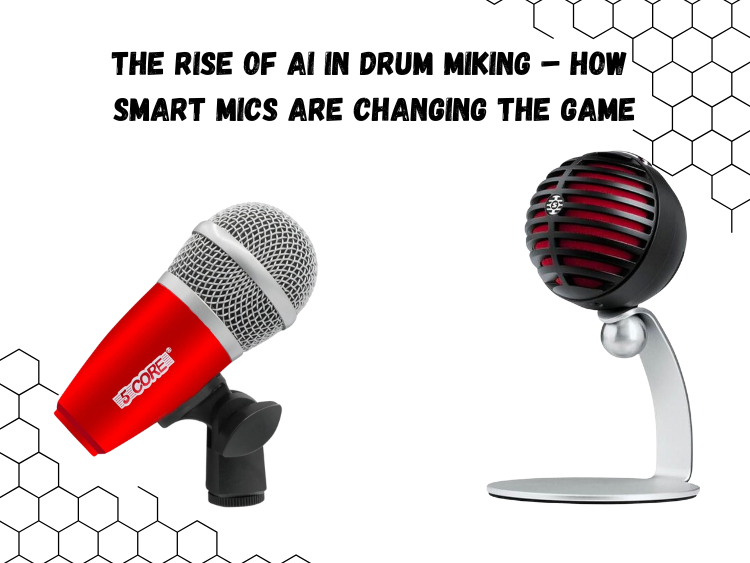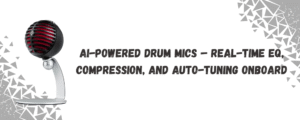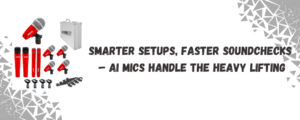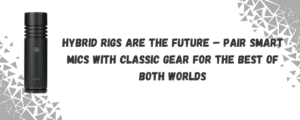AI is showing up everywhere—from DAWs to plugins to actual hardware. And now, it’s creeping into one of the last purely analog holdouts: microphones. More specifically, drum mics.
For decades, drum miking has been a game of placement, technique, and manual EQ. But smart mics are flipping that on its head. They’re listening, analyzing, and adjusting in real-time. No more endless tweaking. No more guesswork. Just plug in, play, and let the mic handle the rest.
But are these AI-powered tools really better? Or are they just another gimmick with a fancy buzzword?
What Makes a Mic “Smart”?
Smart mics use built-in processors and algorithms to automatically optimize the signal before it even hits your interface. That means onboard EQ curves, real-time compression, dynamic gain adjustment, and in some cases, phase alignment between multiple mic sources.
Instead of capturing raw audio and fixing it later, the mic does the fixing as it records.
Some go even further. Certain AI-driven mics listen to the incoming sound, detect what type of drum it is—kick, snare, tom, etc.—and tweak the settings accordingly. Others use pattern recognition to compensate for inconsistent playing or room reflections.
It’s not magic. It’s just software in a metal can. But for drummers, it solves a lot of the usual problems fast.
The Benefits: Faster Setups, Better Consistency
With traditional miking, you’re dealing with mic placement, bleed issues, EQ notching, phase concerns—it’s a lot to dial in. And even after you get it right, you’re constantly chasing consistency across different sessions or venues.
Smart mics eliminate a chunk of that.
They can self-adjust depending on your environment. Some even offer presets tailored to drum types and room size. If you’re recording at home one day and playing a gig the next, the mic adapts. That means tighter mixes, cleaner raw tracks, and way less post-processing.
For live engineers, it’s a game-changer. The soundcheck time drops. The risk of feedback drops. The stress? That drops too.
But Here’s the Catch
AI mics aren’t cheap. And more importantly—they’re not perfect.
Some smart mics over-process the sound, flattening dynamics or coloring the tone in weird ways. Others make assumptions about your setup and apply changes you didn’t ask for. That’s a problem if you’re going for a specific vibe.
You also lose some control. Traditional mics give you raw, untouched material. You can shape it however you want later. Smart mics, on the other hand, bake in adjustments from the start. That can be helpful—or irreversible, depending on the mic.
And of course, the more tech you cram into a mic, the more things can go wrong. Firmware updates, connectivity issues, software glitches—none of that happens with a standard dynamic mic.
The Middle Ground: Hybrid Setups
Right now, the best approach might be somewhere in between.
Use smart mics to handle the heavy lifting—especially in live settings or quick demo sessions. Then, use traditional mics where nuance matters most: kick and snare for punch, overheads for air, close mics for tom control.
Some engineers are pairing AI mics with analog preamps to balance consistency and tone. Others use them for rehearsals, then switch to standard gear for final takes.
It’s not about replacing your whole setup. It’s about making parts of it smarter.
Mics Leading the Shift
Smart mics are still niche, but a few stand out:
Lewitt DTP – This dual-element kick mic uses onboard processing to blend dynamic and condenser elements automatically. You get depth and clarity in one pass.
Aston Stealth – Technically not AI, but it does auto-adjust to voice and instrument types using internal circuitry. No software needed. Think of it as semi-smart.
5 Core 9-Piece Drum Mic Kit – While not AI-powered, it gives you full control over your setup. Pair this with an external smart preamp or digital mixer, and you’re halfway to a hybrid solution.
Interestingly, 5 Core even provides great discounts to business owners if you’re buying in bulk. Refer to this site for more information. Here’s also a one-stop platform where you can find all their products.
Shure Motiv Series (MV88+) – These mics come with app-based processing and real-time DSP. Not drum-specific, but capable of handling percussion with the right settings.
Where It’s Going
The tech is only going to get smarter. We’ll see mics that learn your playing over time, that sync wirelessly to mixers, and that adjust to your band’s live dynamics. Some may even use AI to fix bleed in real-time, isolating each drum without needing gates.
But for now, AI drum mics are best seen as tools—not replacements.
They’re fast. They’re helpful. But they don’t beat experience, ears, and a solid mix engineer.
So if you’re curious, try one. Just don’t ditch your SM57s yet.




